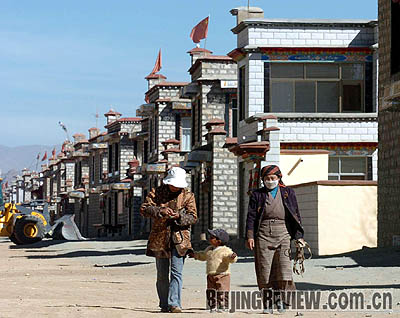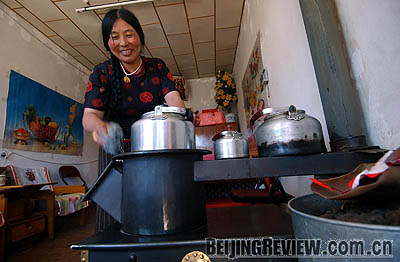|

NEW LIFESTYLE: Ex-nomads walk through a settlement town near Lhasa, Tibet
XINHUA
Like his ancestors, 56-year-old Tibetan Gongbogyia used to live a nomadic traveling life living in a yurt in Luqu County, Gannan Tibetan Autonomous Prefecture, Gansu Province, until two years ago. With the help of the local government, 102 nomadic families, including Gongbogyia's, have now moved into new houses more than 130 square meters large and bade farewell to life on the move.
"The settled life makes it easier for children to go to school and people to go to hospital, and senior citizens can enjoy a better life," said Gongbogyia.
His family has eight members. Gongbogyia has three children, two sons and one daughter. His eldest son is married with two children, and the two younger children are in high school and primary school, respectively.
Compared to his old yurt, Gongbogyia's current home is bright and spacious, bringing the family closer to modern life. Like other settled herdsmen's homes, Gongbogyia's house has been provided with access to a road, tap water, telephone, electricity, and cable TV.
Although this is a new modern home, the decorations of the house still carry strong Tibetan characteristics, and animal husbandry remains the major livelihood for the family. Gongbogyia said his family has over 80 cows and over 200 sheep, which is its entire economic resource. The annual income of the family is over 10,000 yuan ($1,429).
"Living in the settlement homes are mainly elderly people and children while the young travel on the grasslands and live in cabins or tents," said Gongbogyia.
According to Sianmo Dorjei, Deputy Magistrate of Luqu County, his county started the settlement program in 2005. They had planned to build 90 houses, but finally enlarged the number to 102 due to the number of applications from nomadic families. The construction costs for each house were 63,000 yuan ($9,000), of which the government paid 33,000 yuan ($4,700) and the herdsmen's families paid 30,000 ($4,300). Besides four rooms built with bricks and wood, the houses also have a kitchen, glass-roof corridor, lavatory and a Tibetan-style gate.
"Local residents have to apply to join the settlement program and can choose whether to settle or not," emphasized Sianmo Dorjei. He also said, according to the settlement program, Luqu County is going to build seven settlement communities in total, which will accommodate over 600 nomadic families.
Ecological move
Gannan Tibetan Autonomous Prefecture in the southern part of Gansu covers an area of nearly 40,000 square km, of which 62 percent is natural pasture. This makes Gannan a major animal husbandry base in Gansu. Gannan has a population of 580,000, of which Tibetan people account for 48 percent. The Yellow River, considered China's mother river, originates from Gannan and flows across the prefecture.

HOME SWEET HOME: A housewife cleans up in the kitchen of her new house in the settlement community in Luqu County, Gannan Tibetan Autonomous Prefecture
ZHENG MENG
As an important water supply area of the Yellow River, Gannan has a very fragile ecological environment. In the last 20 years, due to manmade and natural factors, such as global warming that has caused a drop in rainfall and overgrazing, wetlands in Gannan have been shrinking and the pasture has been degrading. This has seriously harmed the biological diversity of this area and led to more frequent natural disasters. More seriously, the area's function of conserving water for the Yellow River has substantially weakened, posing a direct threat to the river. Protecting the ecological system in Gannan has become an important measure for protecting the Yellow River.
Since 2005, the prefecture government conducted an in-depth investigation and organized experts and scholars to draft a plan on the protection and development of a major water supply area for the Yellow River. The plan was delivered to the National Development and Reform Commission (NDRC) in June 2007.
On December 20, 2007, the Gannan prefecture government held an inauguration ceremony for the program after the NDRC ratified the plan. This program includes 18 projects in three categories: ecological conservation and repair, living and production infrastructure of farmers and herdsmen and supportive projects. The total investment in the program is around 4.5 billion yuan ($643 million), which has been divided by the local government into two phases, each 10 years in implementation.
The first phase will focus on nurturing forests, returning grazing land to grassland and encouraging immigration to curb the ongoing ecological degradation of the area. The second stage will focus on comprehensive measures to fully recover the water supply capacity of Gannan.
The settlement program for herdsmen in Gannan is one of the projects in the plan, in which NDRC has invested 1.31 billion yuan ($187 million), of which 755 million yuan ($107.9 million) will be spent on property construction, 232 million yuan ($33.1 million) on construction of weather-proof animal sheds and 323 million ($46.1 million) on public infrastructure. After the implementation of the project, 14,524 households and 70,708 people will start a new settled life.
To make sure that resettled herdsmen enjoy a better life in their new homes, the local government has tried to combine the construction of resettled communities with developing tourism on the grassland so that the resettled nomads can change their lifestyles and find new livelihoods.
Extended program
Tibetan nomads in Luqu County have also been part of the resettlement program. The recently resettled Cerang Zhaxi said his family had to live in a tent when they traveled and suffered on cold days. He said he was grateful for the government-sponsored solar power-heated new house, where his family could enjoy a peaceful new life.
"I had never expected to be able to live in such a wonderful house," he said.
By April, 3,506 households with a total population of nearly 20,000 people in Gannan Tibetan Autonomous Prefecture had moved to new resettlement communities under the state-sponsored program. Each of these houses is above 80 square meters in size, complete with weather-proof animal sheds, livestock enclosures and grass storage rooms. The government has also invested in building public facilities around the resettlement communities, such as shops, schools and clinics.
According to an official of the local development and reform commission, the prefecture is going to resettle another 6,686 households of nearly 40,000 Tibetan people in 2008 so that local herdsmen can end their primitive and backward nomadic lives.
Maqu County, in the southwestern part of Gannan, has a total population of around 40,000 people, of which 80 percent are Tibetan herdsmen. As the only county with an animal husbandry economy in Gansu, Maqu still has 6,100 families living nomadic lives. These nomadic people's quality of life is generally poor, without access to information and poor access to schooling, medical care and transport.
Maqu County launched its herdsmen resettlement program on August 20, 2004, before the initiation of the national program. At the launch ceremony, a senior official of the Gannan prefecture government noted that the program was expected to cover the entire nomadic population of the prefecture in three to four years' time.
Of Maqu's first batch of resettlement communities, the largest one is in the southeastern corner of the county's downtown area, covering an area of 195 hectares. The community has 2,000 properties, schools, a hospital, a horse-racing track, a supermarket, a gym and garbage collection stations. The community can provide housing for over 10,000 people. All the houses are of a duplex structure, with a construction area of between 142 and 200 square meters. The designers of the houses have considered the aesthetic value, practical use and living habits of local Tibetan residents. The design bears strong ethnic characteristics.
Lobsang Nyingzhi, a senior official of Gansu Province, said implementing the resettlement program in the water supply area close to the origin of the Yellow River bears historical significance and can be considered a landmark policy for pasture area development after the implementation of a household contract responsibility system for pastures. He thinks it will help to improve the living standards of the people in the pasture area and help to encourage the full recovery of grassland at the source area of the Yellow River. | 